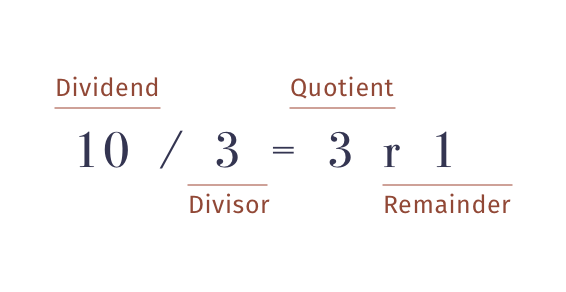In addition to the common operators for addition, subtraction, multiplication, and division, the Python standard library includes some arithmetic operators you may be less familiar with. In this post I'm going to talk about the modulo (%) and floor division (//) operators, and some common pitfalls associated with them.
What do modulo and floor division do?
Modulo
The modulo operator is used to carry out Euclidean division. You almost certainly learnt about Euclidean division in school, even if you didn't know what it was called.
When performing Euclidean division, you start with a dividend (a number you want to divide), and a divisor (the number you want to divide the dividend by). Let's say 10 and 3.
In what we might think of as "standard division" the result of 10 / 3 is 3.333 recurring, or 3 and a third. In Euclidean division, we don't care about numbers after the decimal point. We care about the whole number result of the division (in this case 3), which is called the quotient. The amount left over after the division is called the remainder, which in this case is 1.

To give you another example, 11 / 3 gives us a quotient of 3 and a remainder of 2.
In Python, the modulo operator simply yields the remainder:
>>> 10 % 3
1
>>> 11 % 3
2
Floor division
Floor division is also used to carry out Euclidean division, but unlike the modulo operator, floor division yields the quotient, not the remainder.
Let's look at a couple of examples:
>>> 10 // 3
3
>>> 9 // 2
4
We can create a small function to print out the full result of Euclidean division like so:
def euclidean_division(x, y):
quotient = x // y
remainder = x % y
print(f"{quotient} remainder {remainder}")
euclidean_division(10, 3) # 3 remainder 1
euclidean_division(11, 3) # 3 remainder 2
There is a problem, however. What happens when we call our function with negative numbers?
>>> euclidean_divison(10, -3)
-4 remainder -2
That doesn't look right. -3 multiplied by -4 equals 12, which is higher than 10. The result we should have gotten was -3 remainder 1. So what's going on?
It's floor division's fault
The picture I painted for you earlier about Euclidean division is not entirely accurate. For positive integers, floor division and modulo work exactly like Euclidean division, but things get more complicated when it comes to negative numbers.
The reason for this is to do with rounding. If we look at the Python documentation for arithmetic operators we find a clue about what is going on:
[T]he result [of floor division] is that of mathematical division with the ‘floor’ function applied to the result.
Okay, so let's look at the documentation for the floor function.
Return the floor of x, the largest integer less than or equal to x.
And there's the problem. -4 is considered less than -3.333 recurring. It's further left on the number line. This means that floor division will always round away from zero for negative numbers, but towards zero for positive numbers.
>>> 10 // 3
3 # 3.333 rounds towards zero
>>> 10 // -3
-4 # -3.333 rounds away from zero
>>> 9 // 2
4 # 4.5 rounds towards zero
>>> 9 // -2
-5 # -4.5 rounds away from zero
So what's the problem with modulo?
We've figured out why we're getting unexpected results from floor division and negative numbers, but our remainder was also not what we expected. So why is that?
It turns out that modulo and floor division are closely connected operators, which you may have read if you looked a little further in the documentation. Modulo and floor division are connected by the following identity: x = (x // y) * y + (x % y).
This means that the result of floor division has a direct impact on the result of a modulo operation. We can rearrange the above like so: (x % y) = x - (x // y) * y.
Let's try one of our earlier examples, 10 % -3:
10 % -3 = 10 - (-3) * (10 // -3)
10 % -3 = 10 - (-3) * (-4) # Remember, here floor division rounds away from zero
10 % -3 = 10 - 12
10 % -3 = -2
And we get the exact same result we got before: 10 % -3 = -2.
A few final notes
In this final section, I just want to mention a few other interesting things about modulo and floor division. Before I go into that, however, I think it's important to note that the implementation of floor division and modulo in Python isn't a bug. However, I do think it's important to understand when and how implementations like this differ from our intuitive understanding, because then we can use this implementation as a tool, and it stops being a source of perhaps frustrating bugs.
Type conversion
One of the interesting things about floor division in Python is that it doesn't necessarily produce a floating point number. In fact, in all of our examples, the result was an integer. This is completely different to standard division in Python, which always yields a float.
The modulo operator works the same way, yielding an integer if both operands were integers.
If either operand is a float, both modulo and floor division will yield a floating point number.
Using floats
While the examples in this post have all been integers, it's perfectly possible to use floating point numbers for either operand, and they work exactly the same, they simply yield a floating point number.
An example from the documentation is 3.14 % 0.7, which will yield 0.34.
Complex numbers
Complex numbers are numbers with a real and imaginary part. They're only worth noting here because neither modulo nor floor division can accept a complex number as an operand. Trying to use a complex number for floor division or modulo operations will raise a TypeError.
Recap
- For positive numbers floor division and modulo work like Euclidean division, yielding the quotient and remainder respectively.
- For negative numbers, both operations will yield slightly unexpected results.
- Floor division always rounds away from zero for negative numbers, so
-3.5will round to-4, but towards zero for positive numbers, so3.5will round to3. - Floor division and modulo are linked by the following identity,
x = (x // y) * y + (x % y), which is why modulo also yields unexpected results for negative numbers, not just floor division.
I hope you learnt something new, and if you're looking to upgrade your Python skills even further, check out our Complete Python Course.


